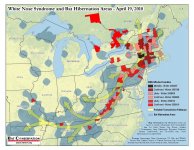An interesting comment from someone on forums.caves.org:
"WNS is a syndrome with symptoms such as mass bat mortality and bats flying around in the winter dying on the landscape. A single bat that appears healthy, but with a small amount of fungus is an infection, not a syndrome. It may seem like splitting hairs, considering the history of WNS in the Northeast, but as more and different species and climates are incountered, we may see different results of Gd infections in bats. For example, no one is stating that there is WNS in Europe, just the fungus and occasional bat infections.
I may seem a little off base here but think about how we used to describe AIDS, a syndrome. At first we didn't know what was going on, so someone came up with AIDS to desribe the situation. Then HIV was found to be causing AIDS. With time more effective drugs and treatments are discoverd treat HIV, and some folks are able to stay healthy for quite awhile. In otherwords they are HIV positive, but do not have the symptoms of AIDS.
We may need to encourge the use of phrases like, Gd. positive for bats and WNS for caves with mortality.
I guess I'm hoping some day to hear things like, 'a bat was found in Cave X that tested positive for Gd. 3 years ago, yet to date there have been no bat mortalities in Cave X that we can attribute to Gd. or WNS' "
This seems like a good idea to me, as single bats don't make syndromes, just infections.
So the US National Wildlife Health Center (part of the USGS) came up with something close to this, with a lot of case definitions fors bats:
http://www.nwhc.usgs.gov/disease_information/white-nose_syndrome/wns_definitions.jsp
This is great news for scientists, but creates a lot of confusion for the media, as they aren't always sure of the terminology they are supposed to use if a singe, or several bats are found infected in a certain area, but the G. destructans fungus isn't found anywhere else (soil, walls, water) in the cave/area.






